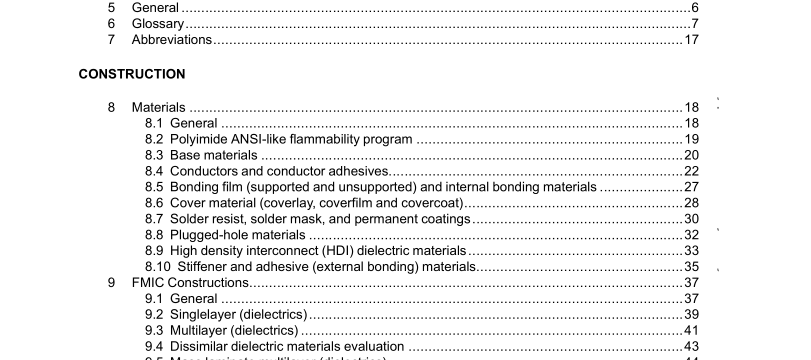UL 796F-2021 pdf download.Flexible Materials Interconnect Constructions.
1.3 Compliance with these requirements does not indicate the product is acceptable for use as a component of an end product without further investigation. 1.4 The singlelayer and multilayer flexible, flex-to-install, and multilayer rigid-flex composite constructions addressed by these requirements consist of conductors affixed to base material, with mid- board interconnections, and cover materials. 1.5 The suitability of additional stiffener and adhesive materials, not evaluated in accordance with Stiffener and adhesive (external bonding) materials, 8.10, the Stiffener bond strength test, 12.12, and Flammability tests, 12.15, are subject to the applicable end-use product construction and performance requirements. See Additional stiffener and adhesive (external bonding) materials, 13.12, for marking requirements for FMIC’s provided with additional stiffener and adhesive materials not investigated. 1.6 The requirements for rigid printed wiring boards are in the Standard for Printed Wiring Boards, UL 796. 2 Units of Measurement 2.1 Values stated without parentheses are the requirement. Values in parentheses are explanatory or approximate information. 3 Supplementary Test Procedures 3.1 These requirements are intended to be used in conjunction with the following requirements or standards: a) The Standard for Polymeric Materials – Short Term Property Evaluations, UL 746A, the Standard for Polymeric Materials – Long Term Property Evaluations, UL 746B, the Standard for Polymeric Materials – Industrial Laminates, Filament Wound Tubing, Vulcanized Fibre, and Materials Used in Printed Wiring Boards, UL 746E, and the Standard for Polymeric Materials – Flexible Dielectric Film Materials for Use in Printed Wiring Boards and Flexible Materials Interconnect Constructions, UL 746F, contain programs for investigating polymeric materials and industrial laminates.
4 References 4.1 Any undated reference to a code or standard appearing in the requirements of this standard shall be interpreted as referring to the latest edition of that code or standard. 4.2 The following publications are referenced in this standard: ASTM D 149 – Standard Test Method for Dielectric Breakdown Voltage and Dielectric Strength of Solid Electrical Insulating Materials at Commercial Power Frequencies. ASTM D 374 – Standard Test Methods for Thickness of Solid Electrical Insulation. ASTM D 1000 – Standard Test Methods for Pressure-Sensitive Adhesive-Coated Tapes Used for Electrical and Electronic Applications. ASTM D 5374 – Standard Test Methods for Forced-Convection Laboratory Ovens for Evaluation of Electrical Insulation. ASTM D 5423 – Standard Specification for Forced-Convection Laboratory Ovens for Evaluation of Electrical Insulation. ASTM D 618 – Standard Practice for Conditioning Plastics for Testing ASTM E 3 – Standard Practice for Preparation of Metallographic Specimens. IPC TM-650 2.1.1 – Microsectioning, Manual and Semi or Automatic Method. ISO 291 – Plastics – Standard Atmospheres for Conditioning and Testing.
5 General 5.1 Acceptability of an FMIC in a device or appliance depends on the acceptability of the construction for: a) Continued use under actual service conditions, including the maximum operating temperature (MOT); b) Flammability properties; and c) All other applicable end-product requirements. 5.2 The investigation of an FMIC shall include consideration of the conductor properties, such as weight (thickness), minimum midboard and edge width, and maximum ground plane area, and shall include the conductor forming and materials build-up processes including solder limits. 5.3 Except as indicated in 5.4, the factors considered in testing the FMIC conductor supporting material in its application shall include mechanical strength, moisture absorption, combustibility, resistance to ignition from electrical sources, dielectric strength, insulation resistance, resistance to arc-tracking, and resistance to creeping and distortion at temperatures to which the material is subjected in the end product. The conductor supporting material shall not display a loss of these properties beyond the minimum acceptable level as a result of aging, and relative temperature indices shall be assigned to the conductor supporting material. UL 796F-2021 pdf download.
UL 796F-2021 pdf download
